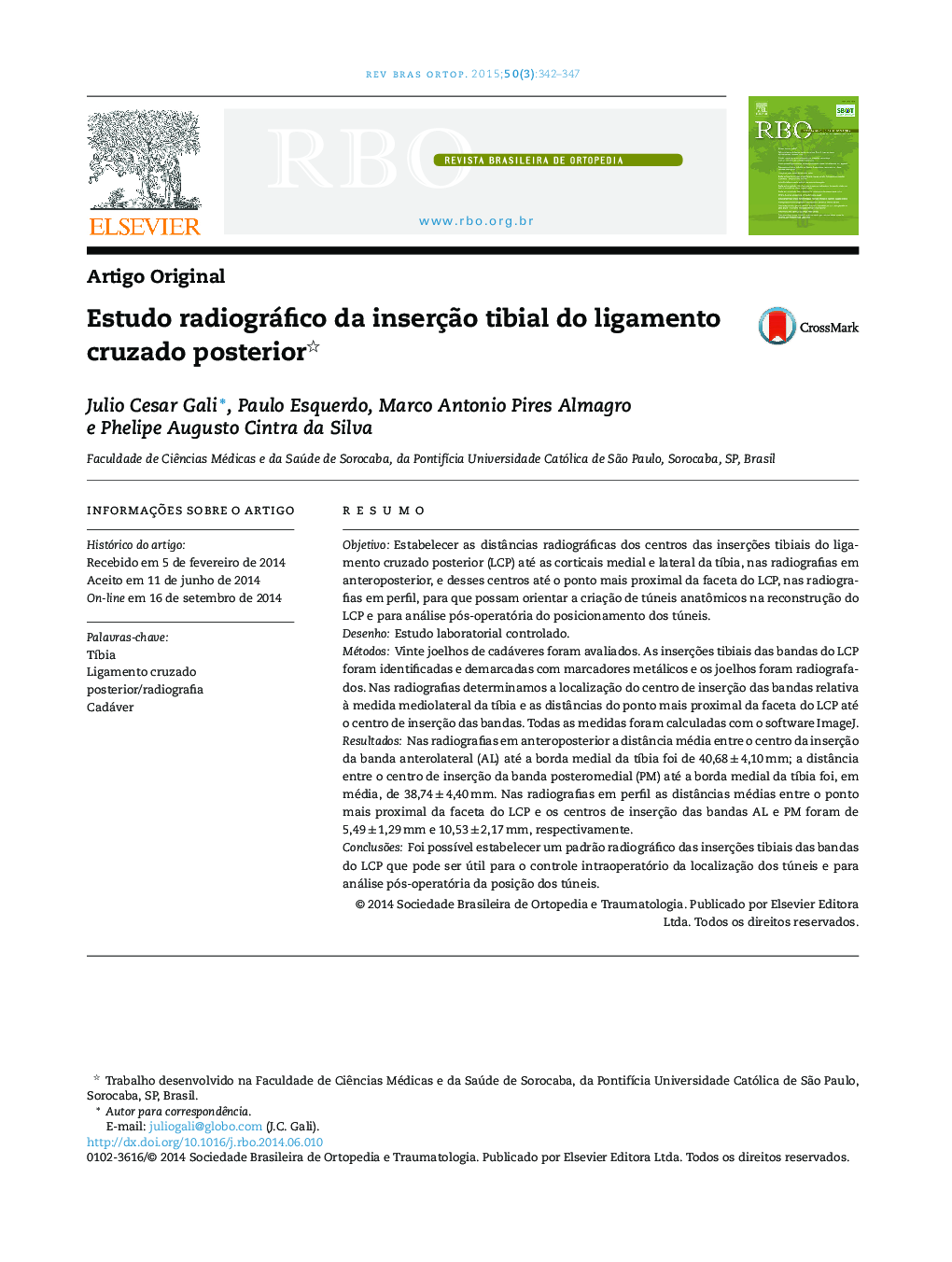| کد مقاله | کد نشریه | سال انتشار | مقاله انگلیسی | نسخه تمام متن |
|---|---|---|---|---|
| 2707506 | 1144856 | 2015 | 6 صفحه PDF | دانلود رایگان |

ResumoObjetivoEstabelecer as distâncias radiográficas dos centros das inserções tibiais do ligamento cruzado posterior (LCP) até as corticais medial e lateral da tíbia, nas radiografias em anteroposterior, e desses centros até o ponto mais proximal da faceta do LCP, nas radiografias em perfil, para que possam orientar a criação de túneis anatômicos na reconstrução do LCP e para análise pós‐operatória do posicionamento dos túneis.DesenhoEstudo laboratorial controlado.MétodosVinte joelhos de cadáveres foram avaliados. As inserções tibiais das bandas do LCP foram identificadas e demarcadas com marcadores metálicos e os joelhos foram radiografados. Nas radiografias determinamos a localização do centro de inserção das bandas relativa à medida mediolateral da tíbia e as distâncias do ponto mais proximal da faceta do LCP até o centro de inserção das bandas. Todas as medidas foram calculadas com o software ImageJ.ResultadosNas radiografias em anteroposterior a distância média entre o centro da inserção da banda anterolateral (AL) até a borda medial da tíbia foi de 40,68 ± 4,10 mm; a distância entre o centro de inserção da banda posteromedial (PM) até a borda medial da tíbia foi, em média, de 38,74 ± 4,40 mm. Nas radiografias em perfil as distâncias médias entre o ponto mais proximal da faceta do LCP e os centros de inserção das bandas AL e PM foram de 5,49 ± 1,29 mm e 10,53 ± 2,17 mm, respectivamente.ConclusõesFoi possível estabelecer um padrão radiográfico das inserções tibiais das bandas do LCP que pode ser útil para o controle intraoperatório da localização dos túneis e para análise pós‐operatória da posição dos túneis.
ObjectiveTo establish the radiographic distances from posterior cruciate ligament (PCL) tibial insertions centers to the lateral and medial tibial cortex in the anteroposterior view, and from these centers to the PCL facet most proximal point on the lateral view, in order to guide anatomical tunnels drilling in PCL reconstruction and for tunnel positioning postoperative analysis.Study designControlled laboratory study.MethodsTwenty cadaver knees were evaluated. The PCL's bundles tibial insertions were identified and marked out using metal tags, and the knees were radiographed. On these radiographs, the bundles insertion sites center location relative to the tibial mediolateral measure, and the distances from the most proximal PCL facet point to the bundle's insertion were determined. All measures were calculated using the ImageJ software.ResultsOn the anteroposterior radiographs, the mean distance from the anterolateral (AL) bundle insertion center to the medial tibial edge was 40.68 ± 4.10 mm; the mean distance from the posteromedial (PM) bundle insertion center to the medial tibial edge was 38.74 ± 4.40mm. On the lateral radiographs, the mean distances from the PCL facet most proximal point to AL and PM bundles insertion centers was 5.49 ± 1.29 mm and 10.53 ± 2.17 mm respectively.ConclusionsIt was possible to establish a radiographic pattern for PCL tibial bundles insertions, which may be useful for intraoperative tunnels locations control and for postoperative tunnels positions analysis.
Journal: Revista Brasileira de Ortopedia - Volume 50, Issue 3, May–June 2015, Pages 342–347